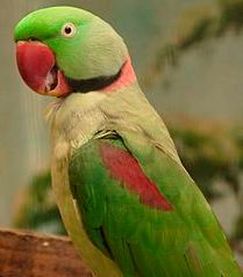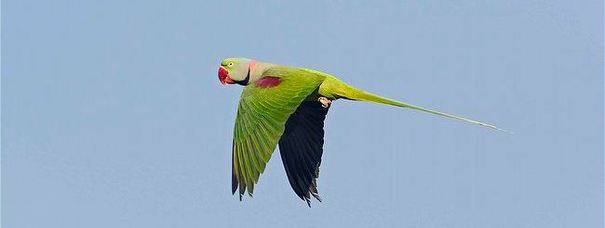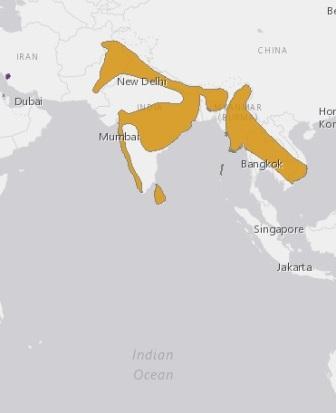Alexandrine ParakeetPsittacula eupatria |

Custom Search
|
|
The Alexandrine parakeet is also known as the Alexandrian parrot or Alexandrine parrot (Psittacula eupatria) is a parakeet species belonging to the psittaciformes order and the Psittaculidae family. They are widespread throughout South and South-East Asia.
It's found in most of India including the Andaman and Narcondam Islands, Sri Lanka, Pakistan, Bhutan, most of Nepal and Cambodia, Bangladesh including Cocos Island, southern and central Myanmar, central Thailand, southern and western Laos and southern Vietnam. They have also naturalized outside their natural range and have been introduced in western Turkey, Iran, Qatar and United Arab Emirates. The species can also be found in the wild in many European countries, namely in the south of England, Germany, Netherlands, Belgium and in Greece. They are found in a variety of habitats such as woodlands, moist and dry forests, deciduous forest, semi-evergreen forest, riverine forest, mangroves, but also cultivated areas and plantations. Usually found below 900 m but they can be found up to 1600 meters in some locations. The Alexandrine parakeet gets its name from Alexander the Great (356-323 BC), who exported them back to the Mediterranean and European regions, marveled by their mimicking ability. There these beautiful birds were considered prized possessions for the royalty and the nobles. Both Romans and ancient Asians were also fascinated by them often making them household pets. Many historians believe that the Alexandrine parakeet was the first parakeet species to reach Europe.
They have a sleek body, large head and bill and a long tapered tail.They are one of the largest species of parakeet measuring up to 23 inches (58 cm) in total length. Adults usually weigh between 7 and 11 ounces (200 and 300 g).
The Alexandrine parakeet long tapering tail reaches between 8.5 and 14 inches (21–35 cm) in length, while the wings measure about 7,5 and 8.5 (19–21 cm) inches long. The Alexandrine parakeet is mainly green colored with a bluish or grayish sheen present on its cheeks and nape, particularly visible in males.Female are usually lighter than the males. The tail feathers underside is all yellow, while the inner tail feathers upper side is bluish-green with a light yellow or white tip. The external tail feathers upper side is green. A maroon or reddish-brown patch located at the top of their wing coverts and commonly called the "shoulder" patch is found in all Alexandrine parakeets despite their age, sex or even subspecies. The Alexandrine parakeet beak is a deep red with a paler yellow tip. Their legs are gray except in the Siamese Alexandrine parakeet subspecies where they are more yellowish-gray. Their irises are yellowish-white while the periophthalmic ring is light gray. The species average lifespan is about 40 years. Subspecies / Taxonomy / Etymology Their scientific name eupatria derives from the Greek. The prefix "eu" translating into noble or good while the suffix "Patria" is the Greek word for fatherland or ancestry. So the meaning of their name is something like "noble nation" or "noble fatherland" or "noble ancestry". Scientists recognize 5 sub-species, many being recognized based on their geographical distribution. Alexandrine parakeet (Psittacula eupatria eupatria) - The nominate species found in East India southward to Hyderabad in Telangana and Sri Lanka. Andaman Islands Alexandrine parakeet (Psittacula eupatria magnirostris) -Has its name implies is found in the Andaman Islands. Indo-Burmese Alexandrine parakeet (Psittacula eupatria avensis) - Found in northeast India to Kyaikkami in Myanmar. Nepalese Alexandrine parakeet (Psittacula eupatria nipalensis) - Found in North and central India, Eastern Afghanistan, Pakistan, Nepal, and Bhutan. Siamese Alexandrine parakeet (Psittacula eupatria siamensis) - Found in the north and east Thailand, Vietnam, Laos, and Cambodia. Diet / Feeding
In the wild, they form small flocks and can be observed on the ground foraging for food. They are omnivores meaning these parakeets feed on a variety of wild and cultivated seeds from flowers and flower buds, nectar, grain, fruits, and vegetables. In some areas is considered a serious pest and in some farmed areas their diet is comprised of 70% of crop seeds. Reproduction In their natural habitat, the breeding season of the Alexandrine parakeet ranges from November to April and is geographically dependent. Females make the nests in tree cavities, palms, and very rare occasions buildings, while the male watches out for danger and feeds the female. The average clutch size is around 2 to 4 eggs, and the number of clutches may reach 2 or 3 per year. The eggs measure about 34 mm × 27 mm (1.34 in × 1.06 in). While the average incubation period lasts about 24 to 28 days and usually starts soon after the 2nd egg is laid by the female. Prior to hatching the chicks poke a small hole from inside the eggs for breathing and they will hatch usually within 1 or 2 days after they made the hole. In the wild the chicks fledging age is around 7 weeks, meaning by that time their feathers are fully grown. Still, in following 3 weeks the chicks are reared, cared for and educated, and normally are weaned at 10 to 16 weeks of age. They reach reproductive maturity at around 3 to 5 years of age. Conservation status and major threats In the past, the Alexandrine parakeet was listed as "Near Threatened" species based on their population trend. But now is considered as "Near Threatened" by the IUCN because even though they remain fairly common in some areas their population is believed to be declining. The mains threats to the species are habitat loss and degradation, persecution and trapping pressure for the pet trade. The Alexandrine parakeet is one of the most sought-after species being widely captured and traded as a cage-bird. Even though their sale is banned in both Pakistan and India we can find Alexandrine parakeets being sold in broad daylight in bird markets. The species is listed under CITES Appendix II. Some parts of its habitat are located in protected areas.
|
Did You Know?
The Nile monitor (Varanus niloticus) is Africa's largest lizard and a voracious predator. Scientific classification
Kingdom: Animalia Phylum: Chordata Class: Aves Order: Psittaciformes Superfamily: Psittacoidea Family: Psittaculidae Subfamily: Psittaculinae Tribe: Psittaculini Genus: Psittacula Species: P. eupatria Subspecies: P. eupatria eupatria P. eupatria magnirostris P. eupatria avensis P. eupatria nipalensis P. eupatria siamensis |



